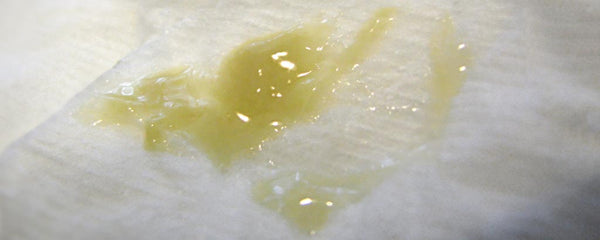Some people have flu-like symptoms. There can be chills, body aches, fatigue, and fever. Pulmonary and nasal passages may add a sore throat, sneezing, or coughing. Is a virus or bacterial infection causing the symptoms?
⚠️ Use Discretion: Graphic phlegm images.
Coughing Up More Than Air
Coughing is an automatic reflex that begins when nerves called cough receptors sense that something has entered your airways that shouldn’t be there. The force behind a cough occurs because the opening to your windpipe (the glottis), located at the back of your throat, momentarily closes as you exhale.
With the glottis closed, extra pressure builds up in your lungs. When the glottis finally opens, the air explodes out up to 50 miles per hour, helping to dislodge up to 10,000 droplets and foreign particles from your airways. [1]
There are many reasons for coughing. These include postnasal drip, asthma, GERD, smoking, inhalation of a foreign object, stress, bacterial infections (pneumonia, pertussis), congestive heart failure, cystic fibrosis, pollution, emphysema, lung cancer, medications, emotional or psychological problems, and tuberculosis.
With irreversible lung damage, Chronic Obstructive Pulmonary Disease is a leading cause of death and illness, mainly associated with emphysema and chronic bronchitis. [2]
Coughs Warranting a Doctor Visit
An internist or pulmonology doctor should examine an unexplained chronic cough. Sometimes influenza can be followed by a more serious lung ailment like bronchitis or pneumonia. Healthcare professionals may perform pulmonary function tests [3] or analyze a sputum culture. [4]
A sputum culture is a test to detect and identify bacteria or fungi (plural of fungus) that infect the lungs or breathing passages. Sputum is a thick fluid produced in the lungs and the airways. Do not use mouthwash before the test since antibacterial substances may skew lab results.
Even without a sputum culture by a physician, you may notice signs of more serious illness when clearing your throat, by examining the color and texture of phlegm. Color can vary from transparent to shades of yellow, green, brown, and gray, depending on the constituents. The phlegm may be a carrier of intestinal parasite larvae.
The color, quantity, and viscosity of your spit speak volumes about your health. Bloody sputum can be a symptom of serious disease (such as tuberculosis or pneumonia), but can also be a relatively benign symptom of a minor disease (such as acute bronchitis). In the latter case, sputum may be lightly streaked with blood. Coughing up any significant quantity of blood is always a serious medical condition. Any person who experiences this should seek medical attention. [5]
A non-productive (dry) cough may become productive, typically associated with a viral upper respiratory tract infection, such as the common cold. Infection causes the mucous membrane of the bronchial tubes to become inflamed and produce thick, sticky mucus. No longer removed by the normal action of the cilia, it clogs the airways. This interferes with oxygen exchange, contributing to weakness and body aches.

Frothy sputum is one of several symptoms that may indicate heart failure, seizures, hypertensive heart disease, pulmonary edema, near drowning, acute mountain sickness, or a rare but potentially deadly infection called (Bubonic, Pneumonic or Septicemic) plague (generally spread from rodents to humans). [6] When accompanied by choking, gagging, unusual pain, or abnormal heart rhythms, seek emergency care.
Heart failure often causes pulmonary edema. Pressure in the veins going through the lungs starts to rise, forcing fluid into the alveoli. This interrupts normal oxygen movement through the lungs and manifests as pink, frothy sputum. Diagnosis is confirmed on an X-ray of the lungs, which shows increased fluid in the alveolar walls. [7,8]
Acute bronchitis often produces thick, discolored phlegm. In some cases, phlegm tinged with bloody streaks appears at the outset and lightens over the next few days. In other cases, white mucus gradually discolors. Coagulated phlegm can interfere with breathing and cause chest discomfort.
Bronchitis Sputum
Productive coughing dislodges phlegm to increase the lungs’ oxygen capacity. There is a mild debate on whether to swallow or spit out phlegm. What is popular in your family? A gastroenterologist recommends expelling into a napkin. This prevents ingestion of potentially harmful bacteria and allows patients to monitor the progression (color) of phlegm.

Thick green sputum
Without adequate liquid, mucus can dry out into thick green boogers (nasal mucus). Drink plenty of water to lighten mucosal viscosity. An over-the-counter cough syrup with expectorant can help loosen congestion. Those with asthma may also require a nebulizer prescribed by a pulmonologist.
If acute bronchitis does not resolve within a week or if it is accompanied by additional serious symptoms mentioned in this article, see a pulmonology physician, as there may be an underlying bacterial infection or some other disease. When in doubt, contact your doctor.
Regardless of the cause, you will feel better if your lungs are clear of phlegm. Stay hydrated [8] and get plenty of rest to boost your immune system and remain healthy.
To support the writing of useful articles about pulmonology, ClinicalPosters sells human anatomy charts, scientific posters, and other products online. You may sponsor specific articles, become a ClinicalNovellas Member, or remit a small donation.
ClinicalPosters sells human anatomy charts, scientific posters, and other products online to offset expense of the writing useful articles about pulmonology. Slide extra posters into DeuPair Frames without removing from the wall.
Show your support by donating, shopping for ClinicalPins, becoming a ClinicalNovellas Member, or leaving an encouraging comment to keep the research going.
To support the writing of useful articles about pulmonology, ClinicalPosters sells human anatomy charts, scientific posters, and other products online. You may sponsor specific articles or remit a small donation.
ClinicalPosters sells human anatomy charts, scientific posters, and other products online to offset expense of the writing useful articles about pulmonology. Slide extra posters into DeuPair Frames without removing from the wall.
ClinicalPosters sells human anatomy charts, scientific posters, and other products online. You may remit a small donation or become a ClinicalNovellas Member.
You can support the writing of useful articles about pulmonology by sponsoring specific articles, becoming a ClinicalNovellas Member, or remitting a small donation. Visible content is optimized for device size.
UPDATED 2025 – This article reflects editorial revisions since its original publication.
FAQ: What do do with your sputum and phlegm
How can coughing spread infection?
The air explodes out up to 50 miles per hour, helping to dislodge up to 10,000 droplets and foreign particles from your airways.
What are some reasons for a persistent cough?
These include postnasal drip, asthma, GERD, smoking, inhalation of a foreign object, stress, bacterial infections (pneumonia, pertussis), congestive heart failure, cystic fibrosis, pollution, emphysema, lung cancer, medications, emotional or psychological problems, and tuberculosis.
When should I visit a doctor for a cough?
An internist or pulmonologist should examine an unexplained chronic cough. A sputum culture is a test to detect and identify bacteria or fungi. Mouthwash may skew lab results.
What does the color of sputum indicate?
Bloody sputum can suggest a serious or minor disease. Coughing up a significant quantity of blood is always a serious medical condition. Frothy sputum may be a symptom of heart failure, seizures, hypertensive heart disease, pulmonary edema, near drowning, acute mountain sickness, or other conditions.
Should you swallow or expel phlegm?
Productive coughing dislodges phlegm to increase the lungs’ oxygen capacity. Spitting it into a napkin prevents ingestion of potentially harmful bacteria and allows patients to monitor the phlegm color.







